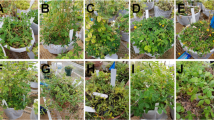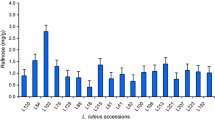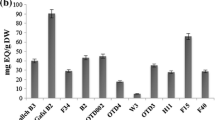Abstract
S. oplocense Hawkes, a wild relative of the potato S. tuberosum L. and source of resistance against the Colorado potato beetle Leptinotarsa decemlineata (Say) (CPB), was intercrossed with S. tuberosum. Backcross clones carried varying levels of resistance. Differences in foliar metabolites between resistant and susceptible clones were analyzed using liquid chromatography-mass spectrometry (LC-MS). Supervised machine learning classification methods uncorrelated shrunken centroids (USC), k-nearest neighbor (KNN) and support vector machines (SVM) were applied to develop algorithms that can classify resistant and susceptible plants using the metabolite data. Five metabolites were found to have a low error rate of prediction of CPB resistance. The five metabolites included two glycoalkaloids previously associated with resistance and susceptibility to CPB, dehydrocommersonine and solanine, respectively. Resistance was associated with a change in composition of glycoalkaloids to higher ratios of dehydrocommersonine over solanine.
Resumen
S. oplocense Hawkes, un pariente silvestre de la papa S. tuberosum L., y fuente de resistencia contra el escarabajo de Colorado Leptinotarsa decemlineata (Say) (CPB), se intercruzó con S. tuberosum. Los clones de la retrocruza conservaron diversos niveles de resistencia. Se analizaron las diferencias en los metabolitos foliares entre los clones resistentes y susceptibles usando espectrometría de cromatografía líquida de masas (LC-MS). Métodos supervisados de clasificación de aprendizaje de máquina no correlacionados con centroides encogidos (USC), k-cercanía de vecinos (KNN) y máquinas de respaldo de vector (SVM) se aplicaron para desarrollar algoritmos que pueden clasificar plantas resistentes y susceptibles usando los datos de los metabolitos. Se encontró que cinco metabolitos tenían un nivel bajo de error de predicción de la resistencia al CPB. Los cinco metabolitos incluyeron dos glicoalcaloides asociados previamente con resistencia y susceptibilidad al CPB, la deshidrocommersonina y la solanina, respectivamente. La resistencia se asoció con un cambio en la composición de los glicoalcaloides a altas proporciones de deshidrocommersonina sobre la solanina.


Similar content being viewed by others
References
Allen, C.F.H., and A. Bell. 1942. 3-amino-2-naphthoic acid. Organic Syntheses 22: 19.
Alyokhin, A., M. Baker, D. Mota-Sanchez, G. Dively, and E. Grafius. 2008. Colorado potato beetle resistance to insecticides. American Journal of Potato Research 85(6): 395–413.
Baxter, H., J.B. Harborne, and G.P. Moss. 1999. Phytochemical dictionary: a handbook of bioactive compounds from plants. Philidelphia: Taylor & Francis.
Boiteau, G., Y. Pelletier, G. C. Misener, and G. Bernard. 1994. Development and evaluation of a plastic trench barrier for protection of potato from walking adult Colorado potato beetles (Coleoptera: Chrysomelidae). Journal of Economic Entomology 87: 1325–1331.
Bozov, P.I., T.A. Vasileva, and I.N. Iliev. 2014. Structure and antifeedant activity relationship of neo-clerodane diterpenes against Colorado potato beetle larvae. Chemistry of Natural Compounds 50(4): 762–764.
Brown, M.P.S., W.N. Grundy, D. Lin, N. Cristianini, C.W. Sugnet, T.S. Furey, M. Ares, and D. Haussler. 2000. Knowledge-based analysis of microarray gene expression data by using support vector machines. Proceedings of the National Academy of Sciences 97(1): 262–267.
Carter, C.D., T.J. Gianfagna, and J.N. Sacalis. 1989. Sesquiterpenes in glandular trichomes of a wild tomato species and toxicity to the Colorado potato beetle. Journal of Agricultural and Food Chemistry 37(5): 1425–1428.
Fernie, A.R., and N. Schauer. 2009. Metabolomics-assisted breeding: a viable option for crop improvement? Trends in Genetics 25(1): 39–48.
Flanders, K., J. Hawkes, E. Radcliffe, and F. Lauer. 1992. Insect resistance in potatoes: sources, evolutionary relationships, morphological and chemical defenses, and ecogeographical associations. Euphytica 61(2): 83–111.
Hashimoto, T., H. Rathore, D. Satoh, J.F. Griffin, A.H.L. From, K. Ahmed, D.S. Fullerton, and G. Hong. 1986. Cardiac glycosides. 6. Gitoxigenin C16 acetates, formates, methoxycarbonates, and digitoxosides. Synthesis and Na+, K + −ATPase inhibitory activities. Journal of Medicinal Chemistry 29(6): 997–1003.
Henderson, C.R. 1984. Applications of linear models in animal breeding. Guelph: University of Guelph.
Jansky, S.H., R. Simon, and D.M. Spooner. 2009. A test of taxonomic predictivity: resistance to the Colorado potato beetle in wild relatives of cultivated potato. Journal of Economic Entomology 102(1): 422–431.
Kessler, N., A. Bonte, S.P. Albaum, P. Mäder, M. Messmer, A. Goesmann, K. Niehaus, G. Langenkämper, and T.W. Nattkemper. 2015. Learning to classify organic and conventional wheat – A machine learning driven approach using the MeltDB 2.0 metabolomics analysis platform. Frontiers in Bioengineering and Biotechnology 3: 1–10.
King, R. R., Y. Pelletier, R. P. Singh, and L. A. Calhoun. 1986. 3,4-Di-O-isobutyryl-6-O-caprylsucrose: the major component of a novel sucrose ester comples from the type B glandular trichomers of Solanum berthaultii Hawkes (PI473340). Journal of the Chemical Society, Chemical Communication 14: 1078–1079.
Kourou, K., T.P. Exarchos, K.P. Exarchos, M.V. Karamouzis, and D.I. Fotiadis. 2015. Machine learning applications in cancer prognosis and prediction. Computational and Structural Biotechnology Journal 13: 8–17.
Lynch, M., and B. Walsh. 1998. Genetics and analysis of quantitative traits, 990. Sunderland: Sinauer Associates Inc.
Marklová, E. 1999. Where does indolylacrylic acid come from. Amino Acids 17(4): 401–413.
McLeod, C. and J.H. Tolman. (eds.) 1987. Evaluation of losses in potatoes. In: Potato Pest Management in Canada-Lutte contre les parasites de la pomme de terre au Canada. Boiteau, G., Singh, R. and Parry R. Agriculture and Agri-Food Canada. Fredericton, NB, Canada, pp. 363–373
Pelletier, Y. 2007. Level and genetic variability of resistance to the Colorado potato beetle (leptinotarsa decemlineata (say)) in wild Solanum species. American Journal of Potato Research 84(2): 143–148.
Pelletier, Y. and R.R. King. 1987. Semiochemicals and Potato pests: review and perspective for crop protection. In Potato Pest Management in Canada, eds. Boiteau, G., R. P. Singh, R. H. Parry. Proceedings of a Symposium on Improving Potato Pest Protection, Fredericton, NB, Canada.
Pelletier, Y., and Z. Smilowitz. 1990. Effect of trichome B exudate of Solanum berthaultii Hawkes on consumption by the Colorado potato beetle, Leptinotarsa decemlineata (Say). Journal of Chemical Ecology 16(5): 1547–1555.
Pelletier, Y., and G.C.C. Tai. 2001. Genotypic variability and mode of action of Colorado potato beetle (coleoptera: chrysomelidae) resistance in seven Solanum species. Journal of Economic Entomology 94(2): 572–578.
Pelletier, Y., C. Clark, and G.C. Tai. 2001. Resistance of three wild tuber-bearing potatoes to the Colorado potato beetle. Entomologia Experimentalis et Applicata 100(1): 31–41.
Pelletier, Y., F.G. Horgan, and J. Pompon. 2011. Potato resistance to insects. The Americas Journal of Plant Science and Biotechnology 5(Special issue1): 37–52.
Rangarajan, A., A.R. Miller, and R.E. Veilleux. 2000. Leptine glycoalkaloids reduce feeding by Colorado potato beetle in diploid Solanum sp. Hybrids. Journal of the American Society for Horticultural Science 125(6): 689–693.
Sanford, L., S. Kowalski, C. Ronning, and K. Deahl. 1998. Leptines and other glycoalkaloids in tetraploid Solanum tuberosum x Solanum chaocoense F1 & F2 Hybrid and Backcross Families. American Journal of Potato Research 75(4): 167–172.
Shipitalo, M.J., and L.B. Owens. 2003. Atrazine, deethylatrazine, and deisopropylatrazine in surface runoff from conservation tilled watersheds. Environmental Science & Technology 37(5): 944–950.
Stemeroff, M., and J.A. George. 1983. The benefits and costs of controlling destructive insects on onions, apples and potatoes in Canada, 1960–80. Ottawa: Entomological Society of Canada.
Szendrei, Z., E. Grafius, A. Byrne, and A. Ziegler. 2012. Resistance to neonicotinoid insecticides in field populations of the Colorado potato beetle (Coleoptera: Chrysomelidae). Pest Management Science 68(6): 941–946.
Tai, G.C.C., A.M. Murphy, and X. Xiong. 2009. Investigation of long-term field experiments on response of breeding lines to common scab in a potato breeding program. Euphytica 167(1): 69–76.
Tai, H.H., K. Worrall, Y. Pelletier, D. De Koeyer, and L.A. Calhoun. 2014. Comparative metabolite profiling of Solanum tuberosum against six wild Solanum species with Colorado potato beetle resistance. Journal of Agricultural and Food Chemistry 62(36): 9043–9055.
Theilhaber, J., T. Connolly, S. Roman-Roman, S. Bushnell, A. Jackson, K. Call, T. Garcia, and R. Baron. 2002. Finding genes in the C2C12 osteogenic pathway by k-nearest-neighbor classification of expression data. Genome Research 12(1): 165–176.
Tibshirani, R., T. Hastie, B. Narasimhan, and G. Chu. 2002. Diagnosis of multiple cancer types by shrunken centroids of gene expression. Proceedings of the National Academy of Sciences 99(10): 6567–6572.
Tingey, W. 1984. Glycoalkaloids as pest resistance factors. American Journal of Potato Research 61(3): 157–167.
Tingey, W.M., and G.C. Yencho. 1994. Insect resistance in potato: a decade of progress. In Advances in potato pest biology and management, ed. G.W. Zehnder, R.K. Jansson, M.L. Powelson, and K.V. Raman, 405–425. St. Paul: APS Press.
Valcarcel, J., K. Reilly, M. Gaffney, and N. O’Brien. 2014. Effect of genotype and environment on the glycoalkaloid content of rare, heritage, and commercial potato varieties. Journal of Food Science 79(5): T1039–T1048.
Vinayavekhin, N. and A. Saghatelian. 2010. Untargeted metabolomics. Curr Protoc Mol Biol Chapter 30:Unit 30 1 1–24.
Weng, C.J., C.F. Chau, K.D. Chen, D.H. Chen, and G.C. Yen. 2007. The anti-invasive effect of lucidenic acids isolated from a new Ganoderma lucidum strain. Molecular Nutrition & Food Research 51(12): 1472–1477.
Yencho, G.C., and W.M. Tingey. 1994. Glandular trichomes of Solanum berthaultii alter host preference of the Colorado potato Beetle, Leptinotarsa decemlineata. Entomologia Experimentalis et Applicata 70(3): 217–225.
Yencho, G.C., S. Kowalski, G. Kennedy, and L. Sanford. 2000. Segregation of leptine glycoalkaloids and resistance to Colorado potato beetle (Leptinotarsa decemlineata (Say)) in F2 Solanum tuberosum (4×) × S. chacoense (4×) potato progenies. American Journal of Potato Research 77(3): 167–178.
Yeung, K., and R. Bumgarner. 2003. Multiclass classification of microarray data with repeated measurements: application to cancer. Genome Biology 4(12): R83.
Zabotina, O.A. 2013. Metabolite-based biomarkers for plant genetics and breeding. In Diagnostics in plant breeding, ed. T. Lübberstedt and R.K. Varshney, 281–309. Dordrecht: Springer.
Acknowledgments
The authors would like to thank Charlotte Davidson, Catherine Clark and Katherine Douglass who provided technical assistance. The work was funded by Agriculture and Agri-Food Canada Agricultural Bioproducts Innovation Program and the Developing Innovative Agri-products program.
Author information
Authors and Affiliations
Corresponding author
Electronic supplementary material
Below is the link to the electronic supplementary material.
ESM 1
(XLSX 2611 kb)
Rights and permissions
About this article
Cite this article
Tai, H.H., Worrall, K., De Koeyer, D. et al. Colorado Potato Beetle Resistance in Solanum oplocense X Solanum tuberosum Intercross Hybrids and Metabolite Markers for Selection. Am. J. Potato Res. 92, 684–696 (2015). https://doi.org/10.1007/s12230-015-9484-2
Published:
Issue Date:
DOI: https://doi.org/10.1007/s12230-015-9484-2




